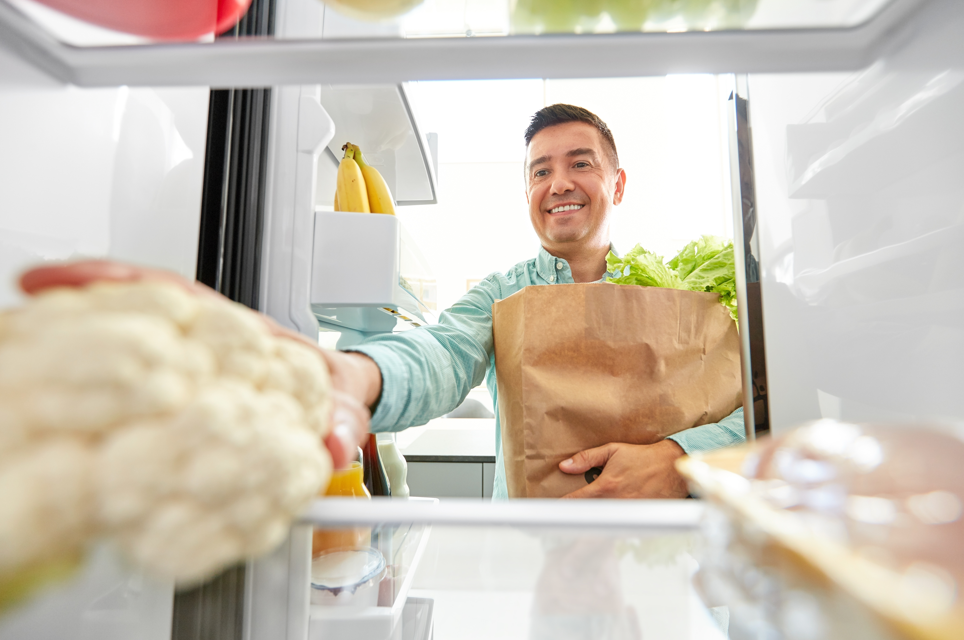Discover More
Tips for refrigerators and freezers
Energy saving tips for refrigerators and freezers
Temperature settings: Storing food at the right temperature is essential for both safety and energy efficiency. Keep your fridge set between 3°C and 5°C, cold enough to preserve food without freezing it. Your freezer should be set to -18°C to keep food safely frozen. Setting temperatures too low can lead to unnecessary energy use. Over-chilled fridges consume more electricity, and overly cold freezers may cause frost build-up, reducing efficiency and storage space.
Let food cool: Allowing leftovers to cool before placing them in the fridge helps avoid raising the internal temperature of the appliance. This reduces the workload on your fridge and saves energy. However, don’t leave food out for too long, perishable items should be refrigerated within two hours to prevent spoilage.
Clean the coils: The coils at the back of your fridge help release heat. When they’re covered in dust, the fridge has to work harder to stay cool. Clean the coils with a brush or vacuum at least twice a year or more often if you have pets. Regular cleaning improves energy efficiency, reduces the risk of breakdowns and helps extend the life of your appliance.
Keep the door closed: Every time a fridge or freezer door is opened, cold air spills out and warm air rushes in, meaning the appliance has to work harder to cool down again. Standing with the door open while deciding what you need wastes energy. Try to plan ahead and decide what you need before opening the door. Reducing the number and length of door openings can significantly cut energy use and keep your food fresher, longer.
Sized right and kept full: A well-sized (not too big) and fully stocked fridge or freezer runs more efficiently. Cold food and drinks retain their temperature better than empty air, helping the appliance maintain a consistent chill with less effort. If your fridge or freezer isn’t full, you can use containers of water or ice to fill empty spaces or crumpled newspaper in freezer drawers to help stabilise the temperature and reduce energy use.
Check the seals: Door seals help keep cold air inside your fridge where it belongs. Over time, they can wear out or collect dirt, allowing cold air to escape and making your appliance work harder. To test your seals, close the door on a piece of paper. If it pulls out easily, the seal may need cleaning or replacing. A tight seal helps maintain efficiency and reduces energy waste.
Location matters: Where your fridge is placed can significantly affect its performance. Avoid positioning it near heat sources like ovens, microwaves, or in direct sunlight. Extra heat forces the fridge to work harder to stay cool. If you’re planning a kitchen layout or renovation, be sure to choose a cool, shaded spot for your appliance.
Allow for Airflow: Ensure there’s at least one inch of clearance around all sides of your fridge to allow proper ventilation. Restricted airflow can cause the compressor to overwork, increasing energy use and shortening the lifespan of the unit.
Energy rating: Fridges have become significantly more efficient in recent years. An older “efficient” model can now cost nearly twice as much to run as a newer one. When it’s time to upgrade, choose the highest energy-rated model you can afford, it pays off in long-term savings. For fridge-freezers, models with top-mounted freezers typically use 10–25% less energy than side-by-side or bottom-freezer units.
Keep It frost-free: Excess frost inside your freezer is a sign of a fault, poor door sealing, excessive moisture, or leaving the door open too long. Frost build-up reduces efficiency and forces the appliance to work harder. Keep doors closed tightly and defrost if needed to keep things running smoothly.
Organise it: An organised fridge isn’t just satisfying—it’s energy efficient. When items are easy to find, you spend less time with the door open, which helps maintain a steady internal temperature and reduces energy use. Group similar items together and keep frequently used foods in accessible spots to make things even easier.
Cover food: Uncovered food and drinks release moisture into the fridge, raising humidity levels and forcing the compressor to work harder. Always cover containers and bottles before refrigerating them. This simple habit reduces energy use and
Privacy Overview
| Cookie | Duration | Description |
|---|---|---|
| cookielawinfo-checbox-analytics | 11 months | This cookie is set by GDPR Cookie Consent plugin. The cookie is used to store the user consent for the cookies in the category "Analytics". |
| cookielawinfo-checbox-functional | 11 months | The cookie is set by GDPR cookie consent to record the user consent for the cookies in the category "Functional". |
| cookielawinfo-checbox-others | 11 months | This cookie is set by GDPR Cookie Consent plugin. The cookie is used to store the user consent for the cookies in the category "Other. |
| cookielawinfo-checkbox-necessary | 11 months | This cookie is set by GDPR Cookie Consent plugin. The cookies is used to store the user consent for the cookies in the category "Necessary". |
| cookielawinfo-checkbox-performance | 11 months | This cookie is set by GDPR Cookie Consent plugin. The cookie is used to store the user consent for the cookies in the category "Performance". |
| viewed_cookie_policy | 11 months | The cookie is set by the GDPR Cookie Consent plugin and is used to store whether or not user has consented to the use of cookies. It does not store any personal data. |





